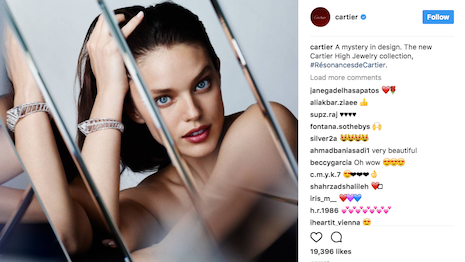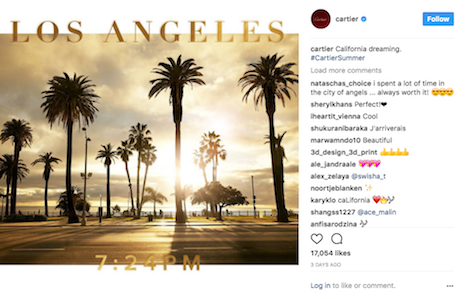 Cartier showcasing its High Jewelry collection to its 5.6 million followers on Instagram. Image credit: Cartier
Cartier showcasing its High Jewelry collection to its 5.6 million followers on Instagram. Image credit: Cartier
By Pau Sabria
If you are reading this, you are likely aware of some of the ever-evolving wants and needs of today’s consumers when it comes to mobile commerce, engagement and advertising.
Consumers want a brand to tell them a compelling story. They need advertisements to be authentic, personalized and relevant to their purchasing interests. They want branded content to evoke inspiration. And they want a frictionless, effective path-to-purchase that allows them to translate inspiration into action.
To meet these demands, now more than ever, it is imperative that businesses make a conscious effort to tap into tools and platforms that drive their marketing objectives and company goals forward.
Earlier this year, Instagram officially expanded its advertising offerings intended to help brands do just that.
With Instagram Stories Ads, brands have the opportunity to strategically target and reach audiences across Instagram's 600 million-plus member community with immersive, short, ephemeral pieces of digital content, creating full-screen experiences like never before.
Between promising campaign results, format versatility and general industry adoption, brands that opt for early adoption are better suited to pull ahead in the digital arms race.
Here are five reasons brands need to start building ads for Instagram Stories today.
1. Love at first sight. Simply put, consumers love Instagram Stories, and the platform is flourishing.
Initial engagement and interaction on Instagram Stories – 200 million consumers are using the feature daily – has proven that consumer adoption is exceptionally promising, and the opportunity for brands to capitalize on such engagement seems to be growing by the minute.
According to Instagram internal data, 70 percent of Instagrammers follow a business, one in five stories on Instagram receive a direct message from viewers and one-third of the most viewed stories are from businesses. So, brands need to act now, or risk becoming obsolete in an ever-evolving social sphere of influence.
2. Viva la vertical video. Vertical video has emerged as a viable content format for brands and consumers alike.
For short, ephemeral content, keeping the video vertical allows the creator and the viewer to hold a mobile device more naturally, resulting in a more comfortable experience with less interference.
Given that Instagram Stories Ads is limited to one piece of media such as a photo or short video, visual content platforms including Content in Motion use professionally produced or user-generated static visual assets to quickly create vertical content that can perform without costly photo or video shoots.
The animated content acts as a bridge between still images and video content, and meets the need for vertical formats within Stories Ads.
Brands using Content in Motion are already seeing significant results, with upwards of a 33 percent lift in post-engagement in social feeds.
3. Options equal opportunity. There are numerous ways in which brands can use Instagram Stories Ads to engage with consumers, and they are able to do it in a more effective, scalable and cost-efficient manner.
Marketers can promote time-sensitive offers, creatively display lookbook layouts, highlight product features and usage, tease upcoming releases, collaborate with partners and individual creators and demonstrate “how-to” tutorials.
4. First “impressions” matter. Instagram Stories Ads are making the right first impression on consumers. Do not just take my word for it, though.
Through collaboration with marketing partners and the developer community, Instagram Stories Ads have generated strong results right out of the gate.
Take, for example, Moen, the number one faucet brand in North America. Moen wanted to see how it could create more dynamic content at scale with Instagram Stories Ads.
Using Content in Motion to create a vibrant, full-screen video ad experience made specifically for Instagram Stories, Moen extended its reach beyond its existing static campaigns with custom animations and branded templates.
This resulted in 45 percent more impressions and a fresh, new way for the brand to create engaging content more quickly and efficiently.
5. Evoke inspiration. With the advent of Instagram shopping, the social platform has been increasingly used as a source of inspiration for consumers, whether it is for beauty, makeup, apparel or home decor.
Given their native occurrence in a user’s Stories library – versus abrupt interruptions and disturbances – Instagram Stories Ads allow brands to connect with consumers in a personal and visually aesthetic way, evoking inspiration that can translate into action and funnel into a key performance indicator, such as completing a purchase transaction.
Now, with a clearer, frictionless path-to-purchase within the application, brands are able to put the consumer first, while still delivering a seamless customer journey that removes barriers to action and potentially even stimulates revenue opportunities.
The cherry on top comes in the form of Mary Meeker’s most recent Internet Trends Report, which stated user-generated content generates almost seven times higher engagement than traditional ads.
 Cartier's Instagram post on California dreaming. Image credit: Cartier
Cartier's Instagram post on California dreaming. Image credit: Cartier
AS BRANDS ADAPT to this ad unit, it will be interesting to see how they are able to best capture the attention of target audiences and convert them into loyal customers and brand advocates.
Given the rapid rate at which content is consumed and the new ad units that are being introduced, brands are urged to join the Instagram Stories Ads strategy now.
In other words, failure to act could mean failure to capitalize on a digital platform ripe for success, especially from a retail perspective.
 Pau Sabria is cofounder/CEO of Olapic
Pau Sabria is cofounder/CEO of Olapic
Pau Sabria is cofounder/CEO of Olapic, New York. Reach him at pau.sabria@olapic.com.